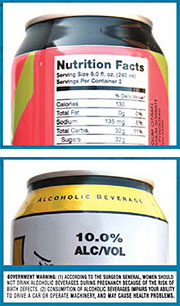The Mix with Dangerous Risks: Energy Drinks and Alcohol
The energy drink craze has exploded over the past few years, including the dangerous practice of combining energy drinks with alcohol. The October 2010 hospitalization of nine Central Washington University students who were consuming a pre-mixed alcoholic energy drink brought national attention to this dangerous combination.
Banned products
Pre-mixed alcoholic energy drink products have now been banned in Washington State by the Washington State Liquor and Cannabis Board (WSLCB). The FDA also took action against four manufacturers of pre-mixed, alcoholic energy drinks, stating that the addition of caffeine to alcohol products is an “unsafe additive.” The companies subsequently pulled their products from the U.S. market. Some have reformulated their product without the added stimulants.
Dangerous mixes
The danger still exists when energy drinks and alcohol are combined by individuals or in bars and restaurants, such as combining energy drinks such as Red Bull with vodka. The stimulants in energy drinks can mask the depressant effects of the alcohol. Consequences include:
- Drinking more than anticipated and/or more than can be safely consumed because the normal onset of sleepiness is delayed
- Inability to judge your level of intoxication because caffeine reduces the feeling of drunkenness, although not the overall level of impairment.
- Taking greater risks, such as driving after drinking, because the combination makes you feel less intoxicated that you are.
Physical effects
In addition to impaired judgment, the combination of a depressant and a stimulant can have a negative effect on the heart. Shortness of breath, rapid heartbeat, and heart attacks can result. For adolescents, pregnant women, and people with certain health conditions, high levels of caffeine are especially risky.
Both alcohol and caffeine are diuretics, and dehydration is another side effect, weakening the body’s defense mechanisms.
Studies back up concerns
Researchers at the University of Florida released findings from a survey of about 800 randomly selected, college-age bar patrons that showed those who consumed alcohol and caffeine were more intoxicated than those who only had alcohol and were four times more likely to say they wanted to drive home.
They say they feel less drunk, but their intoxication levels are masked by the stimulant, making them more prone to injury and alcohol poisoning.
Researchers from the Wake Forest University School of Medicine found that those who consumed energy drinks with alcohol were more likely to:
- Take advantage of or be taken advantage of sexually
- Ride with a drunk driver
- Be hurt or injured
- Require medical treatment as a result of their drinking
Serving alcohol and energy drinks
Anyone serving alcohol may be held liable for injuries suffered as a result of serving someone apparently under the influence of alcohol. Signs of apparent intoxication may become more difficult to recognize when someone is consuming alcohol and energy drinks. Whether you are hosting your own party or serving customers at your restaurant, you can reduce your risk by:
- Deciding not to serve or sell drinks that combine alcohol and energy drinks (restaurant employees should check their company policy)
- Displaying signs that warn about the risks of combining alcohol and energy drinks
- Watching closely for signs of intoxication
- Keeping a close eye on the number of drinks each guest or customer has consumed and cutting them off when appropriate
- Finding your guests a ride home; whether with a designated driver or cab company
- Knowing the signs of alcohol poisoning and how to call for medical help if needed
WSLCB efforts
The WSLCB in 2009 issued a policy banning in our state liquor stores any marketing or promotional material that encourages customers to mix alcohol and energy drinks. In addition, products that contain caffeine, guarana, or any other stimulant, and imply stimulating or energizing effects in its packaging or marketing, will not be sold in WSLCB retail stores.
On November 10, 2010, the WSLCB filed emergency rule to prohibit the sale and distribution of alcoholic energy drinks in the sate of Washington. The emergency rules were in effect for 120 days, during which time the WSLCB sought to make the rules permanent. On March 2, the WSLCB adopted the rule, which will go into effect April 2.
- Press Release: Gov. Gregoire Joins Liquor and Cannabis Board Chair to Announce Ban on Alcoholic Energy Drinks
- Fact Sheet
- Q and A
- Presentation
- Board Resolution
- List of Banned Products
- Permanent Rule on Alcohol Energy Drinks

What you can do
-
Learn more about combining energy drinks with alcohol and the potentially dangerous side effects.
-
Educate others, especially young people. Contact the WSLCB Alcohol Awareness Program Manager for additional information.
-
Know the difference in containers for alcoholic drinks that are packaged to look like energy drinks. Alcoholic drinks are not required to have a nutrition label on their products. However, they must indicate the alcohol content.
- Ask your local store to separate energy drinks from other drinks that contain alcohol. The similar containers can be confusing and misleading.
Resources
Interview: Mary Claire O’Brien, M.D. regarding recent research on alcohol and energy drink
Alcoholic Energy Drinks – Health and Safety Consequences. This report includes links to 2008 studies.